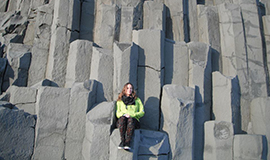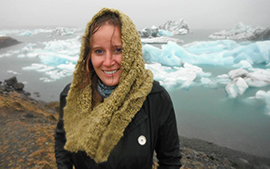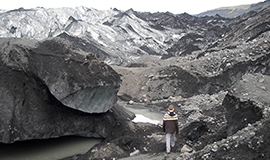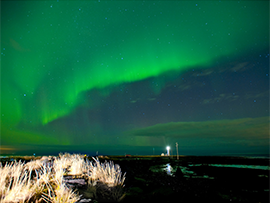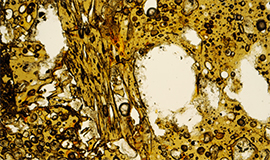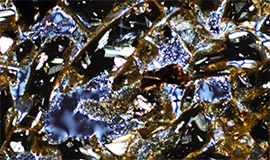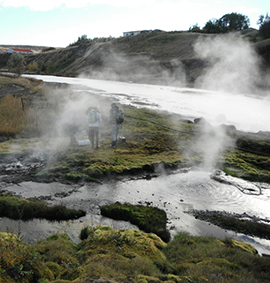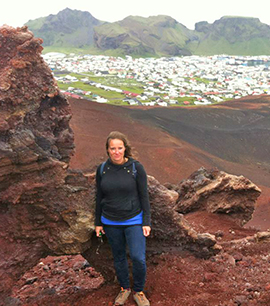Community Engagement, Global Engagement, People, Student Profile
What can Iceland tell us about Mars?
June 22, 2017

About
Name
Erica Massey
Role
Masters student
Program
Earth and Environmental Sciences
Faculty
Irving K. Barber School of Arts and Sciences
Campus
Okanagan (Kelowna, BC)
Education
MSc, Earth and Environmental Sciences (UBC Okanagan, 2017)
BSc, Earth and Environmental Sciences (UBC Okanagan, 2014)
Birthplace
Saskatoon, Saskatchewan
Hometown
Lake Country, BC
"I feel most alive when I’m beside volcanoes and glaciers."
GEOSCIENTIST ERICA MASSEY recently entered Martian territory on a trajectory that duly impressed a researcher for the National Aeronautics and Space Administration (NASA).
The NASA Earth and Space Science Doctoral Fellow reached out to Massey to discuss the UBC Okanagan student’s MSc thesis and fieldwork in Iceland and British Columbia.
Massey’s specialized research focuses on glaciovolcanic geochemistry. Simply put, that involves ancient volcanic eruptions that occur beneath mountainous depths of ice and meltwater. Massey looks at the geochemistry and textures of physical remnants in the aftermath of these Earth-forming fire-and-ice explosions.
The substance Massey chose to focus her thesis on is palagonite, geological material formed from volcanic (molten) glass in the interaction of lava and water. The Canadian Space Agency considers palagonite to be an analogue material for Martian soil and rocks.
Observing the deposits on Mars—with new evidence from NASA’s Mars Reconnaissance Orbiter with its mineral-mapping spectrometer, in addition to the robotic space lab Curiosity rover, in situ since August 6, 2012—may indicate an environment that had life-supporting heat and surface water.
About 1,600 km from the current southern ice cap of Mars are landscapes with similar compositions and shapes to glaciovolcanoes on Earth, so clues to ancient volcanoes that erupted under glaciers on Mars are important to study here on our own planet.
Massey’s rocket-ride into the NASA conversation owes largely to her voracious curiosity about our planet, the universe and deep time. Now she finds herself “breathless” by the reception to her hard-won research accomplishments.
“I first became curious about palagonite when I was on a three-day glacial geology field trip at Sólheimajökull outlet glacier in Iceland,” she says. “My professors, Ólafur Ingólfsson and Guðfinna Aðalgeirsdóttir, truly taught and mentored us from morning to night how to think and act like scientists—to sit in the environment and use critical thinking to interpret the processes.
“It’s quite surreal to go from just being curious about palagonite—this orange-brown-coloured tuff of rock, kind of like the pictures you see of Mars—that I saw at the outlet glacier of the ice cap that rests on top of Katla, one of Iceland’s most feared volcanoes… to this.”
By this, Massey refers to more than just a great connection to NASA, more than the researchers’ reciprocal inspiration, “because there really isn’t anyone else working on this that we know of.”
“There are just so many options for the future that are unknown and exciting.”
FROM THE COMBINE TO THE COSMOS
Massey began her rockin’ journey around the Big Blue Marble in the great outdoors of rural Saskatchewan. She remembers always being outside, running around, early on demonstrating a farm-girl-next-door zeal for exploring terrestrial oddities. For trying new things. Getting her hands dirty.
Massey’s family then moved their large grain operation to Ponoka in the central Interior Plains of Alberta. “It was a good way to grow up in wide open spaces where I could hear coyotes at night,” she says, adding the rarest and faintest of humble-brags: “I know how to run a combine at harvest time!”
Hiking on and around Sólheimajökull glacier, South Iceland with Massey’s “partner in crime”—her adventurous son.
Within 20 years, Massey would be transplanted to Lake Country, BC, just down the road from UBC Okanagan’s campus in Kelowna. Finding herself a single mother of three school-aged children, Massey didn’t choose the easiest or most obvious path. She chose higher education, and it would make her the first on both sides of her family to attend university. (That took courage, right? Massey demurs. “It was an easy decision.”)
During her undergrad studies, she was awarded the opportunity to attend the University of Iceland in Reykjavík through UBC’s Go Global exchange and study-abroad program, taking her three kids (then in Grades 3, 9 and 10) along on an adventure of a lifetime.
Simultaneously being a parent and a university student had a profound effect.
“Being able to share with my kids something bigger than ourselves, and working hard at something worthwhile has made me appreciate opportunities,” says Massey, who counts hands-on learning and extensive fieldwork—climbing into earthquake faults and onto volcanoes and glaciers in remote locations—among her UBC highlights.
“I learned that we’re always taken care of. It’s OK to go to another country and just do something out of the ordinary. And we did it together, going through this special experience—going somewhere different, and with very little—and making the best of it.
“UBC Okanagan’s entire campus made me feel supported throughout the whole process.”
Massey studied for a year at the University of Iceland and saw many sights, including these Northern lights at the Grotta lighthouse in Reykjavik.
During her MSc studies, Massey used the Three Minute Thesis (3MT) academic competition to express her curiosity about palagonite and the implications of her findings. She wanted to go back to Iceland. UBC’s International Education Travel Subsidy—plus, a prestigious, merit-based federal NSERC award (a “lifesaver!”)—allowed her to do just that: Go terrestrial; think extraterrestrial.
“Thankfully,” Massey says, “John Greenough agreed to supervise me on campus and guide me through the whole process. It was important to have the academic and professional support of a supervisor knowledgeable in mineralogy and petrology.”
Along with her UBC professor in Earth and Environmental Sciences (EESC), Massey secured a co-supervisor in UBC alumnus Ben Edwards, co-author of Glaciovolcanism on Earth and Mars (Cambridge University Press, 2016).
“Ben’s name kept coming up,” says Massey about the Professor of Earth Sciences at Dickinson College, Pennsylvania. “He’s one of the world’s foremost experts on glaciovolcanism.”
Edwards helped Massey formulate a plan to compare glaciovolcanism in Iceland to the volcanic field of Wells Gray, BC, 120 km north of Kamloops, which was once buried under an estimated 2 km of ice.
Massey and fellow grad students recently formed the EESC Graduate Society, which plans to make a field trip to Wells Gray an annual tradition—cabins, campfires, hikes and waterfalls in what is called the “Valley of Fire and Ice.”
“Grad students tend to work a lot on their own,” she says. “Community means a lot.”
WHAT LIES BENEATH
At the top of Helgafell’s glaciovolcanic ridge, scrutinizing the basaltic glass and mineralogy with a hand lens.
The northern European island country of Iceland is about the size of the US state of Ohio. Its tableland is riven with structural faults and hundreds of active volcanoes, and is largely covered by dark volcanic rock. More than half of Iceland’s glaciers sit near or directly on active volcanoes.
Massey’s second foray there in 2015 “really opened my mind.” It was spent with University of Iceland researchers on the subject of Surtsey, a 50-year-old seafloor volcanic island about 32 km from the country’s south coast. Surtsey is a World Heritage site, highly protected from human disturbance, though an international drilling expedition is planned for the baby island later this year.
Iceland itself is an island at tectonic ground zero. It floats on a core of molten rock fed by the divergent tectonic plates of the Mid-Atlantic Ridge system, which produces enormous volcanic eruptions. The massive, mysterious underwater mountain range is almost as unknown to scientists as the surface of Mars, Venus or the dark side of the Moon.
Palagonite rims vesicles, grain edges and fractures: Photomicrograph by optical microscope of highly vesicular basaltic glass (honey-coloured) from Helgafell.
Massey says: “The material that I’m studying has been produced through those eruptions. Because there’s such a difference in temperature, the hot magma and cold ice/meltwater instantly makes glass. Other rocks and minerals take time to form. But when magma erupts into water there’s no time to form minerals; it forms glass that has no crystal structure.”
Under the microscopes in UBC Okanagan’s “world-class Fipke Lab” (a.k.a. the Charles Fipke Centre for Trace Element Research), Massey can see the alteration materials being formed from shards of volcanic glass. Surrounding each glass grain is something called a palagonite rim—it is water-quenched and over time completely converted to minerals like clays and zeolites, she explains. The palagonite cements the whole volcanic pile into a rock-hard substance. These materials and minerals are a signature “clue” for similar deposits on Mars.
Palagonitization (conversion of glass to alteration materials) has been integral to synthetic glass studies for use in the nuclear energy industry. Radioactive waste is stored in synthetic glass, which is chemically made to last as long as possible.
Photomicrograph by optical microscope of basaltic glass grains have microlites of plagioclase and olivine minerals, sourced from Wells Gray volcanic field, BC.
Using the latest analytical technology—such as the Scanning Electron Microscope, Laser Ablation, Electron Microprobe and optical mineralogy lab equipment—Massey finds “fascinating and beautiful crystallography and mineralogy, which look really cool, like kinda out of this world.”
Combining methodologies—such as NASA’s use of spectral imaging with Massey’s repertoire—could very well inform what the Mars Society calls “the greatest cause of our generation.”
The Mars Society, a worldwide advocacy group of which Massey is a member, considers the exploration and settlement of the Red Planet as “one of the most daring and audacious human endeavours of our time.”
BRAVE NEW WORLDS
“I feel most alive when I’m beside volcanoes and glaciers,” Massey says. “Iceland is the most ‘alive’ place I’ve ever been.”
Massey and Co.’s geochemical analysis field trip at geothermal hot springs in Flúðir, south Iceland, while studying at the University of Iceland.
Iceland is a hotbed of geological activity—a living lab of earthquakes, geysers, glaciers, volcanoes, and magnificent molten eruptions from the sea floor, deep under the Earth’s crust. Its oldest rocks were formed about 16 million years ago, but new land is constantly being created in the inexorable convergence of fire and ice.
This aqueous environment produces different materials than above-ground eruptions—and questions lingered: What are the controlling mechanisms that chemically convert glass to palagonite, along with secondary minerals? What controls the process, especially the original composition of the basaltic glass, whether it’s on Earth or another planet?
This spring, Massey completed her thesis, which shows geochemical-textural relationships in glass and palagonite that have never been published before. Different patterns, lines and spheres, some almost vein-like. Other researchers have seen textures that indicate microbial organisms that “eat” (break down) the glass.
Early morning hike up Eldfell volcano on Heimaey island, off the coast of south Iceland—not far from Surtsey island.
“In the lab, I’ve been able to traverse the glass and palagonite at the scale of 1 micron (1/1000th of 1mm) that shows how the chemistry is changing—which hasn’t been shown before quite like this, not at least how I’m going to do it. Finding clues, y’know?”
Some think that in the ancient Earth, with all the volcanism and water, early life could have happened in those extreme environments. Massey claims to have found textures similar to ones in those studies, which links into Mars research, too.
Heat + moisture = microbial life. Or does it?
“Scientists are really interested in finding some form of life—it’s like a new frontier,” she says. “I want to believe. Actually, I do believe.”
Along with Greenough and Edwards, Massey was mentored by the late Sveinn Jakobsson, a pioneering geologist at the Icelandic Museum of Natural History and a world expert in palagonite research. While on the Surtsey project, Massey sat down with Jakobsson at his workplace. “I showed him the photos I had, and he was really encouraging and excited that someone was working on this. He gave me some pointers,” she says. “It was pretty special.”
On another occasion, one of the most “momentous” of her academic life, Massey and Edwards, on the perfect chance, were in Iceland at the same time. Together they walked the entire ridge of Helgafell—Icelandic for “Holy Mountain”—where the ocean floor rises up to become part of the island. The tectonic plates are separating, and geological and geothermal activity abounds.
“Trying to figure out what we are looking at is like a mix of detective work, chess, and thinking really, really big outside of the box, while mixing in chemistry, physics and geology,” Massey says.
The panoramic view from the top of Helgafell overlooks lava fields that go for miles without a plant or tree in sight.
In southern Iceland, Massey poses on a volcanic glacial outwash with a large boulder rock that was powerfully carried by a glacial flood during Katla’s 1918 glaciovolcanic eruption.
“For some reason it is utterly beautiful and stunning. We talked about the most amazing things related to geoscience. It felt like Ben taught me about 20 geology classes in our one hike.
“I am forever grateful for those moments where my professors and mentors really took the time to teach outside where it all happens, and to inspire us to think like scientists.”
So there was Massey and Edwards at Helgafell, both UBC alums, nerds for science, together, side by side by side with an international crew of fellow curiosity rovers, all decidedly not alone in the universe.
Looking out over the great expanse from the top of a holy mountain, they watched the birth of new lands, of new worlds in their becoming.
It was one heck of a field trip.
HORIZON GOALS
‘Nature follows certain laws’
Theories exist that say an ocean of ice lives under the surface of Mars, and that, if terraformed, the Red Planet could be habitable by humans as early as this century.
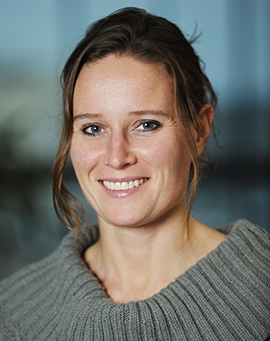
The Mars Society is a worldwide advocacy group that considers the exploration and settlement of the Red Planet as “one of the most daring and audacious human endeavours of our time.”
Erica Massey has daring and audacity in spades—plus, her membership in the Mars Society puts her in good research company, among the likes of SpaceX and Tesla founder Elon Musk, arguably the world’s most-influential cheerleader for interplanetary exploration.
Musk is a modern-day explorer who’s predicting a Martian landing in about 10 years. Meanwhile, NASA’s forecasting a safe mission in the 2030s.
Whatever the “horizon goal” actually is—and given China and Russia’s technological bravado—the race to Mars is very much on.
Why Earth and Environmental Sciences?
Meanwhile, Massey has her eyes on Surtsey, a volcanic island off the south coast of Iceland, and the polar ice caps. “My dream is to have the experience to work in Antarctica or the Arctic—so incredible, like Iceland. It’s beautiful because it’s almost like new earth, unexplored. Mineral exploration, prospecting and geoscience are my passion and I look forward to working further in this field.”
Massey has been offered an award to present her research in July 2017 at the International Clay Conference in Granada, Spain, which features such sessions as “Clays as Decoders of Extraterrestrial Environments.” By then, she will be a full-fledged UBC alumna apprenticing as an APEGBC Geoscientist-In-Training towards becoming a licensed Professional Geoscientist.
In the fall of 2017, Massey (her fingers are crossed) could join the team of scientists drilling into the seabed under Surtsey’s volcanic island.
What’s important is, Massey has found what she loves to do and that includes teaching students of all ages, from lecture halls to labs, teaching assistantships to field trips in elementary schools and with university students.
“My perspective is so broad now!” she says. “I’ve learned about the Universe, the Earth, the planet’s core. Nature follows certain laws. Now I understand my surroundings.
“Before, I felt like I was just living. I didn’t understand how nature works, didn’t look at mountains and think about why or how they exist. That’s why I love teaching kids—elementary students are incredible, they’re so fascinated to learn about nature, their surroundings and space. Like, how hot is it 20 km under our feet?!
“Then again, we think we know everything about Earth, but we don’t.” She giggles.
Credits
Story by Chris Bowerman
Photos courtesy of Erica Massey
Published March 30, 2017
